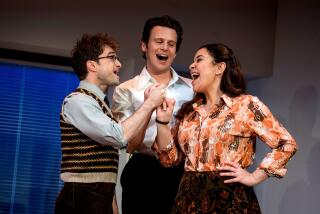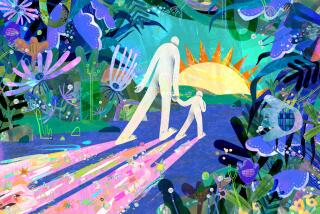Word Play: A ‘Frog and Toad’ discovery
Toad looked at the sunshine coming through the window.
“Frog,” he said, “I am so glad that you came over.”
“I always do,” said Frog.
Frog, reliable, sunny and optimistic, and Toad, curmudgeonly and in constant need of shoring up, have one of the great friendships in children’s literature. Arnold Lobel’s four books about these great pals, published from 1970 to ‘79, are a mainstay of HarperCollins’ “I Can Read” series and have set several generations of children on the path to reading.
Readers have a chance to see another facet of Frog and Toad in “The Frogs and Toads All Sang” (HarperCollins: $16.99, ages 4-7), a newly discovered work by Lobel, who died in 1987. The text was written some 10 years before the Frog and Toad books; the illustrations are his own drawings colored by his daughter, Adrianne Lobel. The ten poems in the new book don’t yet have the particular characters of Frog and Toad that readers came to know later, but the sensibility is emerging.
The most striking absence is that Lobel had not yet developed the friendship between Frog and Toad; these poem-stories are about frogs and toads as a group. Yet many of the elements in the later books are already there. Lobel always dressed his animals properly; Frog and Toad are never seen without their jackets unless they are hibernating, in which case it’s gentlemanly pajamas. In the title poem of “The Frogs and Toads All Sang,” there is a party at which
The ladies wore long dresses
And the gentlemen wore pants.
Part of the gentle humor in the “Frog and Toad” stories is that while the friends are highly civilized, they are also children, so in this party scene:
They danced in the meadow.
They danced in the street.
They danced in the lemonade
Just to cool their feet.
Readers can see the beginnings of Toad’s melancholy in the poem “Bright Green Frog” (clearly, Lobel had not yet established the essential difference between sunny Frog and anxious Toad). The frog plays his violin “with skill and grace” but wears “a frown upon his face”:
“I fiddle well.”
He sighed.
“And yet . . .
I’d rather play
The clarinet.”
That is what Adrianne Lobel calls “a profound adult problem -- people can be good at one thing but want to do another” as well an example of her father’s refusal to “condescend to children.”
True to biology, the poem “Made for Toads” observes that dry-dwelling toads prefer sunny days, while frogs prefer rainy days. That would suggest that in Lobel’s children’s book universe, Toad might have come out with the cheery temperament, and Frog the gloomy one. But here in “A Toad Was Feeling . . . “ might be the clue to the later Toad’s never feeling quite right in his skin:
A toad was feeling
Sad and grumpy
Because his skin
Was rough and lumpy.
This poem concludes with one of the most solid elements of the Frog and Toad stories, the discovery of a simple comfort -- in this case, a soft fur coat to soothe the toad’s sense of malaise.
The new books were discovered last year, when a rare book dealer contacted Adrianne Lobel and offered her some handmade books by her father that had been found in an estate sale. At first Adrianne wasn’t too interested.
“I had seen a lot of my father’s work,” she said. “We have archives full of rough sketches, and notebooks full of writing. We’ve given a lot to the Eric Carle Museum [in Amherst, Mass.].”
But she quickly changed her mind. What the dealer was offering were three complete books that Arnold Lobel had made as gifts for family friend Crosby Bonsall, also a children’s book author.
“I was amazed that my father had done them without my knowing about them,” Adrianne said, “probably when my brother and I were asleep.”
The three little books are “particularly sweet,” Adrianne says, because they were finished volumes, complete with covers, “in cardboard sleeves he had made for them and covered in Italian paper.” Under the dust jacket of the HarperCollins edition of “The Frogs and Toads All Sang,” readers can see the original penciled cover, set on a background of the marbled Italian paper.
Adrianne took the little books to her father’s publisher, HarperCollins, which jumped at the chance to publish new work by Arnold Lobel. The three handmade books have been edited into two volumes, one about frogs and toads -- “for the obvious reasons,” said Adrianne -- and one about owls and pigs. The second book, “Odd Owls and Stout Pigs,” will come out in November.
Adrianne, a theater designer by profession and a painter by avocation, set about adding color to the pencil illustrations. This might have been a daunting prospect, except that she had some experience translating her father’s work, having produced the successful Broadway musical, “A Year With Frog and Toad.” (I recommend keeping an eye out for a production of “A Year with Frog and Toad” and finding the cast recording; the songs are a thoroughly delightful interpretation of the stories, done in a 1930s-musical style.)
“I bought myself some really nice new art supplies, a couple of sets of Dr. Martin’s dyes, for this project,” Adrianne said, “They’re intense watercolors that come in old-fashioned ink jars. They give a stained-glass look, with jewel colors. I looked at my father’s later, full-color work. He didn’t get to do much work in full color.”
Most of Arnold Lobel’s work was done in line illustration, then in two-color overlay for the old color-separation printing process. “If you wanted Toad to be brown,” Adrianne explains, “you’d combine, for example, 70% red and 30% green on two overlays. You couldn’t see how it would look, you’d just guess. It was impossible! My mother did a lot of the separation for him.”
The advances in printing have given the frogs and toads in the new book a wide palette and much more vibrant colors than the old, dull green and brown of the old Frog and Toad books. “I’m going down to the City next week to see the second book coming off the press,” Adrianne said. “It’s fun to see how close they can get to the colors of the painting now.”
Adrianne changed very little about the pictures or text. On her father’s original cover, the frog and toad each have only one leg, while sharp-eyed readers will see that on Adrianne’s dust jacket illustration, they look more balanced with all limbs in place.
The poem “Polliwog School” is her favorite, Adrianne said, “because that is where Frog and Toad met, as tadpoles. Frogs and toads both start in ponds, but toads leave the pond and live on land, while frogs stay in water.”
“I had always credited myself with teaching my father the difference between frogs and toads. I kept toads as pets, and one day he said to me: ‘What a nice frog.’ I was furious: It was a toad! They’re different, I explained. They have different lives and personalities. Then we went to a drive-in movie. It was a horror movie, ‘Frogs,’ and they used TOADS! I was irate! When I saw these books, they predated that summer, so I realized he must have known the differences. I do this with my daughter now; when your kids are explaining something you say, ‘Oh, really?’ You want to find out what they know. He must have been humoring me.”
Bolle’s Word Play column appears monthly at www.latimes.com/books.
More to Read
The biggest entertainment stories
Get our big stories about Hollywood, film, television, music, arts, culture and more right in your inbox as soon as they publish.
You may occasionally receive promotional content from the Los Angeles Times.






